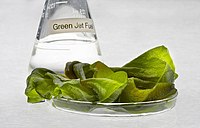
Sulfated exopolysaccharide production and nutrient removal by the marine diatom Phaeodactylum tricornutum growing on palm oil mill effluent
Sign Up to like & getrecommendations! Published in 2019 at "Journal of Applied Phycology"
DOI: 10.1007/s10811-019-01780-2
Abstract: Palm oil mill effluent (POME) is the major source of environmental hazard in palm oil industry. Yet, due to its high nutrient content, POME may offer opportunities for the growth of algae as a source… read more here.
Keywords: palm oil; production; phaeodactylum tricornutum; tricornutum ... See more keywords

Quantitative label-free proteomics and biochemical analysis of Phaeodactylum tricornutum cultivation on dairy manure wastewater
Sign Up to like & getrecommendations! Published in 2021 at "Journal of Applied Phycology"
DOI: 10.1007/s10811-021-02483-3
Abstract: Microalgae cultivation on wastewater offers the dual benefit of lowering costs for feedstock production with simultaneous wastewater remediation. This study utilized biochemical and quantitative label-free proteomic approaches to evaluate the growth and proteomic response for… read more here.
Keywords: wastewater; quantitative label; phaeodactylum tricornutum; tricornutum ... See more keywords

Efficient removal of dyes from seawater using as biosorbent the dead and living biomass of the microalga Phaeodactylum tricornutum: equilibrium and kinetics studies
Sign Up to like & getrecommendations! Published in 2021 at "Journal of Applied Phycology"
DOI: 10.1007/s10811-021-02513-0
Abstract: Dyes are used in many applications with their consequent discharge into aquatic environments. Alternative methods of pollutant removal, such as biosorption, are currently necessary to achieve an efficient, low-cost, and environmentally friendly process. The biomasses,… read more here.
Keywords: microalga phaeodactylum; phaeodactylum tricornutum; living biomass; biomass ... See more keywords

Comparative toxicity of nano ZnO and bulk ZnO towards marine algae Tetraselmis suecica and Phaeodactylum tricornutum
Sign Up to like & getrecommendations! Published in 2017 at "Environmental Science and Pollution Research"
DOI: 10.1007/s11356-016-8343-0
Abstract: The wide use of ZnO nanoparticles in a number of products implies an increasing release into the marine environment, resulting in the need to evaluate the potential effects upon organisms, and particularly phytoplankton, being at… read more here.
Keywords: bulk zno; nano zno; zno; tricornutum ... See more keywords

ROS changes are responsible for tributyl phosphate (TBP)-induced toxicity in the alga Phaeodactylum tricornutum.
Sign Up to like & getrecommendations! Published in 2019 at "Aquatic toxicology"
DOI: 10.1016/j.aquatox.2019.01.012
Abstract: As a newly emerging environmental contaminant, tributyl phosphate (TBP) is an additive flame retardant of high production volume that is frequently detected in biota and the environment. Despite evidence that TBP is a potential threat… read more here.
Keywords: tributyl phosphate; phosphate tbp; phaeodactylum tricornutum; tricornutum ... See more keywords

Pre-treated digestate as culture media for producing algal biomass
Sign Up to like & getrecommendations! Published in 2017 at "Ecological Engineering"
DOI: 10.1016/j.ecoleng.2017.05.007
Abstract: Abstract An agro-zootechnical ultrafiltered digestate (UF) coming from an anaerobic digester plant was used to grow two strains of microalgae: Chlorella sp. and Phaeodactylum tricornutum , in a comparison with standard substrates. Chlorella sp. and… read more here.
Keywords: treated digestate; biomass; pre treated; tricornutum ... See more keywords

Photochemical features and trace element substituted chlorophylls as early detection biomarkers of metal exposure in the model diatom Phaeodactylum tricornutum
Sign Up to like & getrecommendations! Published in 2018 at "Ecological Indicators"
DOI: 10.1016/j.ecolind.2017.07.057
Abstract: Abstract Establishing marine species equipped with efficient biomarkers of trace element stress is a major requirement for the assessment of trace element contamination in marine ecosystems. This study investigates PS II overall activity and efficiency… read more here.
Keywords: element substituted; substituted chlorophylls; phaeodactylum tricornutum; tricornutum ... See more keywords

Mechanisms underlying silicon-dependent metal tolerance in the marine diatom Phaeodactylum tricornutum.
Sign Up to like & getrecommendations! Published in 2020 at "Environmental pollution"
DOI: 10.1016/j.envpol.2020.114331
Abstract: Anthropogenic activities have significantly changed the stoichiometry and concentrations of nutrients in coastal waters. Silicon (Si) has become a potential limiting nutrient due to disproportionate nitrogen, phosphorus, and silicate inputs into these areas. The disrupted… read more here.
Keywords: marine; underlying silicon; metal; diatom ... See more keywords

Phaeodactylum tricornutum microalgae as a rich source of omega-3 oil: Progress in lipid induction techniques towards industry adoption.
Sign Up to like & getrecommendations! Published in 2019 at "Food chemistry"
DOI: 10.1016/j.foodchem.2019.06.004
Abstract: Diatoms are a major group of high omega 3-fatty acid producing algae that play a key role in global climate change and ecosystem function. Phaeodactylum tricornutum is one of only two diatoms whose genomes have… read more here.
Keywords: lipid induction; phaeodactylum tricornutum; oil; tricornutum ... See more keywords

Evaluation of anaerobic digestates from different feedstocks as growth media for Tetradesmus obliquus, Botryococcus braunii, Phaeodactylum tricornutum and Arthrospira maxima.
Sign Up to like & getrecommendations! Published in 2017 at "New biotechnology"
DOI: 10.1016/j.nbt.2016.12.007
Abstract: In this paper, two freshwater microalgae (Tetradesmus obliquus and Botryococcus braunii), a marine diatom (Phaeodactylum tricornutum) and a photosynthetic cyanobacterium (Arthrospira maxima) were investigated for their ability to grow on liquid digestates (LDs). Three LDs… read more here.
Keywords: tetradesmus obliquus; braunii; tricornutum; growth ... See more keywords

Optimized mRuby3 is a Suitable Fluorescent Protein for in vivo Co-localization Studies with GFP in the Diatom Phaeodactylum tricornutum.
Sign Up to like & getrecommendations! Published in 2020 at "Protist"
DOI: 10.1016/j.protis.2020.125715
Abstract: Phaeodactylum tricornutum is an ecologically and evolutionarily relevant microalga that has developed into an important model for molecular biological studies on organisms with complex plastids. The diatom is particularly suitable for in vivo protein localization… read more here.
Keywords: protein; microscopy; fluorescent protein; tricornutum ... See more keywords